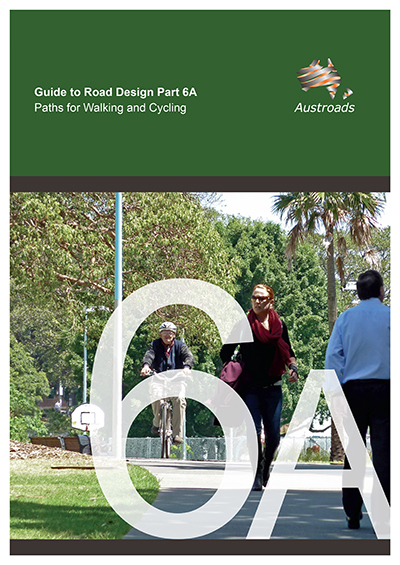Road Design

- Publication no: AGRD06A-17
- ISBN: 978-1-922382-21-4
- Published: 11 February 2021
- Edition: 2.1
- PDF (free) Download
- View online View guide
Guide to Road Design Part 6A: Paths for Walking and Cycling provides guidance for designers and other practitioners on the design of paths for safe and efficient walking and cycling, both within the road corridor and outside the road corridor. The guide provides information on considerations that should be given in providing a path, describes the types of paths and covers the requirements of path users, e.g. operating spaces, factors that influence path locations, and geometric design criteria for a path and related facilities such as intersections between paths, and terminal treatments. Detailed guidance is provided on path location, alignment, width, clearances, crossfall, drainage and sight distance requirements.
The location and design of paths may be influenced by a range of aspects that need to be considered and facilities that need to be accommodated within roadsides. In particular, designers should refer to the Guide to Road Design Part 6: Roadside Design, Safety and Barriers and Part 6B: Roadside Environment.
The design of pedestrian and cyclist paths may also be influenced by design considerations and requirements covered in other parts of the Guide to Road Design. In addition, road designers should also refer to relevant parts of the Guide to Traffic Management in relation to traffic management devices and requirements that may need to be accommodated within a roadside or may otherwise influence the design.
Edition 2.1 has minor editorial and technical changes to Figure 1.1, and Section 2.2 and 5.10.
Edition 2.0 has been restructured and contains editorial and technical changes. The title has been amended to better reflect the information on the functions and types of paths covered in this edition. Updated information and new information have been included with the key changes as follows:
- Sections 1 to 4 has been reworded to provide generic information that is relevant for pedestrians and cyclists.
- Section 1.1: Universal Access – additional information on providing universal access.
- Sections 2.2: Pedestrian Path and 2.3: Bicycle Path – amended to include information on levels of service.
- Section 3: Path User Considerations – amended to broaden the range of path user considerations.
- Section 3.2.1: Pedestrians – amended to include information on mobility scooters.
- Section 5.1: Width of Paths – additional information for path widths based on volumes.
- Section 5.7: Sight Distance – additional commentary on pedestrian needs and sight distance and replacement of Figure 7.7 with an equation to determine stopping sight distance.
- Section 6.5: Special Treatments for Intersections of Paths with Paths – new section consolidating treatments for special circumstances.
- Section 7.3: Treatments for Intersections of Paths with Roads – new information on path terminal treatments.
- Section 7.5: Special Treatments for Intersections of Paths with Roads – new section on terminal treatments for special circumstances.
- Section 8.3: Culvert Underpasses – new information on principles in providing paths through culverts.
- Appendix B: Speed Limiting Treatments – new appendix providing information on speed limiting treatments on paths.
- Appendix C.3.1: Bituminous Surface Pavements – additional information on bituminous surfaces.
- Appendix C.4: Life Cycle Costing – new section on life cycle costing.
- Commentary 1: Planning and Need for a Path – transferred from Section 2 as information relates to network plans and operation.
-
-
-
-
-
-
-
Tables
-
Figures
